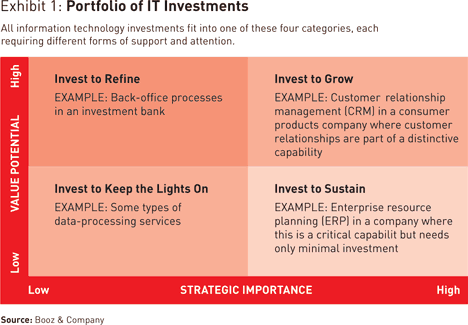Road Map to Relevance
How a capabilities-driven information technology strategy can help differentiate your company.
Here is a situation that is all too familiar at corporations around the world. The third quarter has just begun. The chief information officer and other senior information technology leaders are enmeshed in a flurry of activity, writing up their proposed capital investment budgets for the coming year. Knowing that unforeseen demands are inevitable, they introduce placeholders into the budget: unspecified project lines to be filled in later.
Fast-forward to the end of the following year. Sure enough, unexpected problems and needs have arisen. Those placeholders have become hidden buffers that IT executives dip into to fund cost overruns, project scope creep, and a variety of pet projects that would not have passed the rigorous scrutiny of the formal budget process. Meanwhile, in the wake of the financial crisis, severe capital constraints are making it impossible to pay for all these buffers. The funding for placeholders is questioned, even as the demand for expanded service grows more insistent. The IT department bears the brunt of the blame and pressure, but the actual problem goes deeper: The entire company is at a strategic impasse.
Underlying this impasse is an outmoded way of managing requests for information technology development and support. Corporate IT investments — which added up to more than US$1.3 trillion worldwide in 2009, according to Gartner Inc. — are allocated in most companies through a fragmented process. In many companies, requests are submitted on a project-by-project basis, each with its own business case. Most funding grants are based on historical spending patterns and financial projections, not on the strategic needs of either the full company or the individual businesses. Local teams tend to execute their IT projects in isolation from one another. The results are often suboptimal, and the costs are far greater (per dollar of revenue) than they would be if there were an ethic of sharing IT projects among as many products and services as possible.
Worse still, as each project encumbers the underlying enterprise architecture with new requirements, it becomes inflexible and layered with unnecessary complexity. Some business units refuse to retire older systems, even when they have been replaced by newer ones elsewhere in the company. As a result, the fixed costs of IT operations rise; when old systems aren’t retired, every dollar of new IT support raises ongoing base costs by 10 to 15 percent. Ultimately, local leaders lose confidence in IT altogether. They come to see it as a pure cost center: a necessary evil for keeping the business engine running.
The alternative is to build a company-wide rationale for information technology, bringing the internal supply (IT function) and demand (business unit) sides together to focus investment on the few distinctive capabilities that set the company apart. Most top executives understand this reality. They recognize the strategic value of visionary IT leadership, especially in helping their companies understand which strategies are most viable. Some companies have been able to achieve that kind of IT leadership. But many do not know, in practice, how to get there from where they are today.
If you are a CEO or executive leader seeking better strategic value from IT, or a CIO or IT leader determined to provide it, then you (and your IT department) can achieve this goal. But you will need a capabilities-driven IT strategy: a road map to strategic relevance. Over the past five years, a number of companies have put these road maps in place, and achieved a new kind of IT and operational leadership. If you want to join them, your journey will have four stages. In each one, you answer a fundamental question about the role of IT in your business. First, what are your company’s distinctive capabilities — those that support your strategic priorities — and how can they be improved with information technology? Second, how should you prioritize your IT projects accordingly? Third, what sequence of investment and activity will allow you to reach the goals you’ve set, and close the gaps you need to close? And fourth, what kinds of cultural and governance support do you need to put this IT strategy into practice?
An explicit road-mapping exercise can play a vital role in recasting your IT function. In this respect, it is very different from a conventional “big bang” technology plan, such as an enterprise resource planning (ERP) renewal effort. The road map forces you to put aside any current efforts to define IT projects or assess solutions packages, and to base your judgment instead on the way your company creates value, on the investment needed for your differentiating capabilities, and on the contribution that IT must make.
1. What Capabilities Matter?
In this foundational first stage of your journey, the leaders of your enterprise IT function come together with the business leaders of your corporation to reach a mutual understanding of business priorities. This starts with the articulation of your overall strategy: the ways that your company generates value for its customers now, and how it expects to do so in the future. As Paul Leinwand and Cesare Mainardi point out in The Essential Advantage: How to Win with a Capabilities-Driven Strategy (Harvard Business Press, 2010), a strategy like this can succeed only if it is supported by a system of well-developed, applicable capabilities that reinforce one another. (See “The Right to Win,” by Cesare Mainardi with Art Kleiner, s+b, Winter 2010.)
Corporate capabilities and information technology are intertwined in every company, but the relationship between them is often misunderstood. A capability is the ability to reliably and consistently deliver a specified outcome relevant to your business. This capability is ensured through a combination of processes, tools, knowledge, skills, and organization that are all focused on meeting the desired result.
Companies have hundreds of capabilities — all companies must, for example, maintain competent facilities management and legal staffs to remain in operation. But the capabilities that matter most are those that are distinctive. They are refined and proficient to the point that they differentiate your company; they give you the ability to approach the market in ways that few others can emulate. This requires so much investment and attention that even the largest, most powerful corporations can afford to keep up only three to six world-class capabilities. In the most successful companies, these capabilities are applied to all products and services in a coherent fashion. Fulfilling them becomes the top priority for all the major functions, especially those related to talent (such as human resources and learning and development) and processes (such as operations and IT). Although strong IT support is required for every corporate activity, the most important focus for IT investment and design should be the three to six capabilities that matter most.
One well-known example of the difference that distinctive IT-related capabilities can make is provided by Amazon, the world’s foremost online retailer. Amazon’s strategy has drawn heavily on IT and the involvement of highly skilled IT strategists. Its capabilities include very sophisticated interface design and customer relationship management, broadly integrated analytics, and the rapid deployment of new technologies such as cloud computing and printing on demand.
To be sure, as an Internet-based company, Amazon might seem atypical, but the same level of technological integration is a hallmark of leading companies in every industry. For example, consumer products companies increasingly distinguish themselves through IT-enabled customer relationships or value chain management. Engineering-oriented companies carve out their identity through their unique approach to innovation, which also needs in-depth IT support. And distinctive IT-enabled capabilities are beginning to play a similar role in the downstream oil and gas industry (that is, everything involved in taking raw fuel to market, including refining, processing, distribution, and retail).
Margins are razor-thin (usually pennies per gallon) in downstream oil and gas operations, which typically require coordination among a variety of businesses and franchises. Inaccurate or delayed information on fuel inventories and supply positions can destroy that margin very quickly. This can happen, for instance, when oil and gas companies contract to supply fuel at competitive prices, and then discover that their own supplies can’t cover those commitments; they must then go to third parties to buy the product at higher spot prices.
The most capable downstream companies have managed this by building distinctive capabilities in value-chain integration. They use their own proprietary information technology to create an information-rich trading and supply system that links all the critical points in an oil distribution network. Wholesale prices flow from the market to the trading and pricing desks; crude oil supply, logistics, and cost data are used to adjust the production schedules in refineries and the inventory levels in terminals and storage facilities; and decision makers at every point have a clearer understanding of the customer demand, product movement, and available margins throughout the system. Operations complexities, rather than being treated as a series of impediments to overcome, are regarded as an ongoing strength. The company can routinely offer more competitive prices and make more ambitious supply commitments without having to go into crisis mode to deliver them.
In this stage, drawing on the overall corporate strategy, you spell out those three to six distinctive capabilities that your strategy depends on, the ways in which information technology supports them, and the ways in which they could be better supported by IT. The senior executives responsible for overall strategy and the IT leaders can accomplish this only if they work together. The CIO plays a role that may seem unusual in some companies: He or she doesn’t just recommend and build the best IT packages, but also counsels the strategic team by informing and challenging its choices. By asking for a more explicit view of these key strategic levers and offering his or her own assessment of what it will take to develop them, the CIO brings a crucial element to the decision — the understanding of how technology can help create and capture advantage.
2. How Do You Prioritize?
In this second stage, conducted largely by the CIO and the rest of the IT team, you create a functional strategy. You look freshly at your priorities, assess the gaps between your current services and your goals, and estimate the benefits and costs for closing each of these gaps.
Start with an assessment of your IT portfolio, including every project for which you’ve planned investment in the current and next fiscal year. Rank them high or low on two criteria. The first criterion, based on stage one, is strategic importance: the extent to which these investments will be needed for your company’s distinctive capabilities. Remember to focus on their relevance to the entire company, not to individual business units, products, or services.
The second criterion is value potential. Assess each project’s anticipated return on your investment, either through improved performance and reduced cost or through the value gained in fulfilling a strategic purpose. Given the pressure on capital, you will need to consider whether these investments are “self-funding”; in other words, whether they lead to near-term cash savings, to growth that covers the costs of the information technology investment, or to both. You need not make an exhaustive inventory of all projects, but you do need enough detail to make cogent decisions about every major investment.
As you rank each of the projects, you will find they naturally fall into one of four categories. (See Exhibit 1.)
• Invest to grow. The most important IT projects are those with high strategic importance and high value potential. They are best positioned to help grow the top line, filling in the gaps in the capabilities you need most. For example, in the United States, some healthcare industry leaders, such as Aetna Inc., are investing heavily in customer relationship management, customer call centers, and claims automation. This ongoing focus on capabilities, driven by the CEO and the executive team as well as by the IT function, enables these companies to serve an expanding base of customers — a critically distinctive position in the wake of the 2010 Patient Protection and Affordable Care Act. In your company, these investments should be amortized across most or all products and services, and thus be large enough to fulfill your expectations for them. For maximum effectiveness, implement these projects with full coordination among IT, operations, and learning and development.
• Invest to sustain. Some strategically important capabilities may already be relatively well developed in your company, in which case further investment has low value potential. For example, some companies rely on ERP to outmatch competitors in logistics, but they have not made full use of all the data that the system produces. It may require only marginal improvement to realize the full potential of these projects. Plan your investments accordingly, aware that you may need to increase funding if competitors catch up.
• Invest to refine. Most CIOs have become adept at fine-tuning projects, gaining efficiencies, improving operations, and cutting head count. The projects in this category often benefit from that type of attention. They are economically viable, but not tied to the strategic priorities of the firm. Many of them amount to “table stakes,” the capabilities that every company needs just to stay in business. For example, companies can’t operate without e-mail and a firewall. But these capabilities may not need to be world-class. How can you outsource them or provide them at a lower cost, or else make them more effective?
• Invest to keep the lights on. Take a hard look at projects with little discernible strategic importance and low intrinsic value potential. These may be legacy projects or projects supported by only a small part of the organization. Should they remain part of your portfolio? If they are needed to “keep the lights on” for some part of your business, can you scale them back?
Your categorization will probably reflect the needs of your particular industry. For example, in an expanding consumer products company with multiple new offerings and markets, you can expect a large number of projects to fall into the “invest to grow” category. But in a commodity-oriented chemicals company, the total investment will be smaller and the proportion of “invest to refine” and “invest to keep the lights on” projects should be higher.
Finally, having sorted the projects into these categories, evaluate the levels of investment they will need. This process is akin to the “solution blueprinting” processes that many IT departments conduct. Which gaps need to be filled? How large an investment will be needed to bring each project to fruition, and what will be the benefits? The lion’s share of investment will probably flow to the “invest to grow” category, but you may also need to reserve some extra support elsewhere — for example, in some “invest to refine” projects.
3. What’s the Right Sequence?
The third stage involves developing a more detailed road map for using IT to deliver these capabilities. What is the right sequence of investments? What technical constraints and interdependencies among projects should be taken into account? How will your new investments alter the underlying information architecture that you have developed? What assets can be retired, and how soon? How many of the one-off requests that have filled up your investment portfolio in the past can be eliminated? This is also the stage during which you set design and technical specifications and select particular enterprise solution packages.
This stage does not require a multiyear planning outlook. Instead, after an initial launch session your IT road map should become a living document, jointly maintained with the business organizations and continually updated as the company’s strategic priorities change. Make regular course corrections based on rigorous value, risk, and market assessments; refresh the road map as new opportunities arise to generate value. At the same time, keep your decisions tightly linked to the portfolio decisions you made in stage two.
A good example of the road map process took place in 2009 at an electric utility company in the United States. Before building its road map, the IT department received funding requests based on historic allocations for dozens of different projects, including six related to its supply chain. Most of the business cases were not well substantiated. Then the IT leaders reviewed the company’s overall strategy. They saw that it incorporated a sophisticated supply chain capability encompassing efficient procure-to-pay processes, better management of working capital, and the minimization of commodity risk exposure. They realized that their function could contribute several components: analytics on spending, “demand planning” (using statistical methods to more accurately forecast customer needs), end-to-end online management of contract workflow, market intelligence, and improved category management.
But to provide all this, they would have to fill a series of critical gaps within the function. These included strengthening the skills of the category manager, collecting better information about demand, tracking vendor performance for services, setting up software connections between packages (such as Power Advocate and Oracle), building an automated contract management workflow, developing a more consistent product hierarchy (to solve an ongoing problem with miscoding), and storing profile and performance information as part of the vendor master records. These priorities did not match the wish lists of the company’s business leaders, whose individual demands focused on far less strategic measures: the procurement of services, contract management systems, and a new electronic sourcing initiative. In the end, by having a capability-centric road map in place, the IT department could delay or defer less-relevant requests.
4. What Support Do You Need?
If asked whether they have a technology road map for the whole company — a developmental path for making IT more strategic — many CIOs would say they do. But in practice, most of those blueprints are developed with very little input from other business leaders. Answering a few diagnostic questions can help CIOs better demonstrate their ability to create value. (See Exhibit 2.)
Exhibit 2: Diagnostic Questions for Chief Information Officers
1. Do we understand how the business creates value in the marketplace?
2. Do we know what the business needs from IT to accomplish this?
3. Can we show how every dollar we spend in IT creates value for the business?
4. Are we contributing to the capabilities that really matter for our company’s strategy?
5. Have we identified the biggest gaps between the current state of our IT and the value creation system that we’re building?
6. Are we developing our investment road map jointly between business leaders and IT?
7. Do we use this road map to determine capital and resource allocations?
8. Do we have the governance mechanisms in place that we need to follow our road map?
9. Do we understand how the evolution of technology may enable improvements in our distinctive capabilities?
10. Do we consistently refresh the road map, update our IT architecture, and retire outdated systems as needed?
Source: Booz & Company
One key success factor is full support from the CEO, and from other primary leaders throughout the organization. This road map will determine which IT investment decisions are approved and how rapidly they are implemented. Business leaders must take the road map into account when considering new technology requests and investment opportunities. Prioritizing investments must be a joint business and IT effort; if IT is left alone to decide on priorities, the road map will not achieve the buy-in required to successfully deliver results. IT leaders, for their part, will need to maintain a high level of judgment: revising the road map when appropriate, distinguishing full-enterprise from business unit priorities, measuring output as well as compliance, holding to the priorities that are set (recognizing that even the largest companies can’t do everything at once), and keeping the core function thin, flexible, and pragmatically close to the work.
The Leader’s Advantage
If you are a CEO, a CFO, or a business leader, you should insist that the IT function develop a complementary road map for its investments. Your business and IT leaders should develop this road map collaboratively. Conversely, if you are a chief information officer seeking to adopt this sort of road map, you may find yourself alone at first. You will need to influence the culture and governance systems of the larger company. You might, for example, seek to include the IT road map process in annual strategic planning exercises, set up joint business–IT governance councils, or establish new metrics for the performance and relevance of IT projects. You will need to insist on broad business participation in high-level IT decisions. Finally, you might seek IT oversight policies such as those imposed at Royal Dutch Shell PLC, where 80 percent of IT spending was dedicated to the 200 most strategically important applications.
Now is the time to raise the bar on IT investment planning, to make sure investment capital is used to position the business for success. As a CIO or IT leader, you must focus on enabling the corporate strategy, not fighting about technology standards or managing budgets. As a CEO, a CFO, or a business leader, you must seek to understand how technology can enable your capabilities, instead of simply trying to reduce your unit service cost. The integral role of IT gives you a unique vantage point from which to help the business identify the right capabilities and bring them together across the value chain. With a well-designed road-mapping process, you can give IT the role that it deserves. ![]()
Reprint No. 10404
Author profiles:
- Eduardo Alvarez is a Booz & Company partner based in Chicago, and leads the firm’s global operations practice. He specializes in business process and IT-enabled transformations for energy, chemicals, and utilities companies.
- Srini Raghavan is a principal at Booz & Company based in Washington, D.C. He specializes in technology strategy, service delivery models, and capabilities-driven business transformation for the energy, chemicals, and utilities industries.
- Also contributing to this article were Booz & Company Partner Michael Connolly and Principal Dirk Klemm, and s+b contributing editor Edward Baker.
- This article was previously published in IT Foresight, Booz & Company’s monthly electronic newsletter on technology; see www.strategyand.pwc.com/it-foresight.





